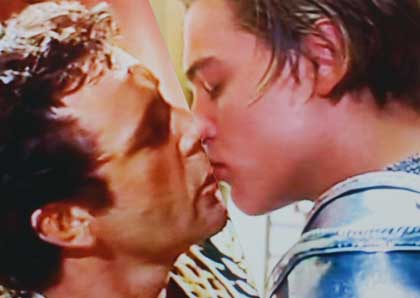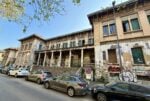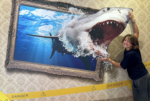Kensuke Koike – Searching for a perfect

Non c’è archivio, né accumulo di tempo in Kensuke Koike ma organico fluire delle forme che trasmigrano da un’immagine all’altra. Non siamo solo dinanzi a quel trovato o ritrovato che svela il processo cognitivo di ricollocazione del senso e dello sguardo, ma dinanzi alla creazione di altro, nato per gemmazione e che risponde ad esigenze di vita autonoma.
Comunicato stampa
JARACH GALLERY
KENSUKE KOIKE
SEARCHING FOR A PERFECT
Non c’è archivio, né accumulo di tempo in Kensuke Koike ma organico fluire delle forme che trasmigrano da un’immagine all’altra. Non siamo solo dinanzi a quel trovato o ritrovato che svela il processo cognitivo di ricollocazione del senso e dello sguardo, ma dinanzi alla creazione di altro, nato per gemmazione e che risponde ad esigenze di vita autonoma. Non vi è solo un recupero di riproduzioni obsolete per una inedita semiologia dell’immagine, ma questa viene adoperata di nuovo con lo scopo di costruire un organismo differente, perennemente in connessione. Come nel filmato rielaborato o nella composizione-manifesto, l’opera perde la sua funzionalità, la referenzialità con il reale, rivelando così non solo il suo doppio ma una miriade di vettori che accrescono le sue potenzialità immaginative. La discussione non verte più sul binomio verità / finzione ma sull’analisi del processo di posizionamento continuo di senso, quale condizione ontologica di fronte al reale e alla sua rappresentazione. L‘incongruità apparente quindi è un processo che si compie per accostamento, per illustrare un nuovo testo e rendere visibile la dimensione dialogica che intercorre fra il significato originario e sconosciute concatenazioni narrative. In questo procedere Koike è sempre sovversivo, perchè scardina e smaschera la logicità e l’ordine di lettura per rigenerare la retina e la sua dinamicità propulsiva, seguendo una trama che conduce quasi ad una mise en abyme. Entrare nel suo mondo è come colpire uno specchio, spezzare l’insieme, produrre orientamenti, parziali, riflessioni multiple, sfaccettature ossimoriche. Un’alterazione da ricomporre con forme poliedriche che tengano assieme le differenze, affinché si puntellino vicendevolmente e raggiungano linee di pendenza capaci di riequilibrare la velocità fra comunicazione dell’immagine e la sua fruizione, creando piani dove la storia possa scorrere al tempo giusto.
Un dispositivo, quello dell’artista, che riflette, interpreta, produce velocemente sempre qualcosa di autentico, perchè parte di un tutto di cui siamo ben consapevoli. Alla fine è come il distillato di un racconto con radici e ramificazioni rizomatiche, aperto ad accogliere e unire suggerimenti provenienti da tempi e luoghi differenti. “Voglio essere lupo, uccello, tigre. Mi annoio a essere uomo”, mentre un nuovo immaginario metamorfico evidenzia la mostruosità insita nelle pieghe della ‘forma bella’.
I’m not what you think: ma non so neppure io cosa sono diventato.
I’m looking for a perfect.
Andrea Bruciati
JARACH GALLERY
KENSUKE KOIKE
SEARCHING FOR A PERFECT
There is no archive, nor time accumulation in Kensuke Koike but instead an organic flowing of lines and shapes, which transmigrate from an image to the next.
We are not just faced with that particular discovery or re-invention which reveals the cognitive process of re-collocation of meaning and vision, but also, we witness the creation of a new one, originated by budding and responding to the needs of an autonomous life.
There is not just a restoration of obsolete reproductions for a brand new semiology of the image, but this latter is used again to the purpose of creating a different organism, one that is constantly connected. As in the re-elaborated video or in the manifesto-composition, the artwork loses its functionality, its referentiality to the real, thus revealing not only its double but also a plethora of vectors which increase its imaginative potentialities.
The debate doesn’t deal with the truth/fiction pair any more, but it has to do with analysing the process of a continuous placement of meaning, as the prime ontological condition up against the real and its representation. The seeming discrepancy is therefore a process which progresses through juxtaposition, in order to illustrate a new text and to unveil the dialogic dimension which exists between original meaning and unknown narrative concatenations.
In such approach, Koike is always subversive, since he disproves and exposes the cogency and the reading sequence with the intention of regenerating the retina and its propulsive dynamicity, by following a plot which leads almost to a mise en abyme.
Entering his world is like hitting a mirror, pulverizing the whole, creating directions, sketchiness, multiple reflections, oxymoronic facets. An alteration that has to be reassembled with multifaceted shapes in order to keep differences together, so that they would support each other and reach grade lines capable of finding a new equilibrium between the speed of image communication and its fruition, thus creating levels where history can flow at the right pace.
A device belonging to the artist who ponders, enacts and quickly produces something which is always authentic, since it is part of a whole we are well aware of. In the end, it resembles the distillate of a story with roots and rhizome branches, open to welcome and bring together suggestions coming from various times and places. “I want to be a wolf, a bird, a tiger. Being a man bores me”, while a new metamorphic imaginary highlights the monstrosity in the folds of the “good shape”.
I’m not what you think: but I don’t even know what I have become.
I’m looking for a perfect.
Andrea Bruciati



